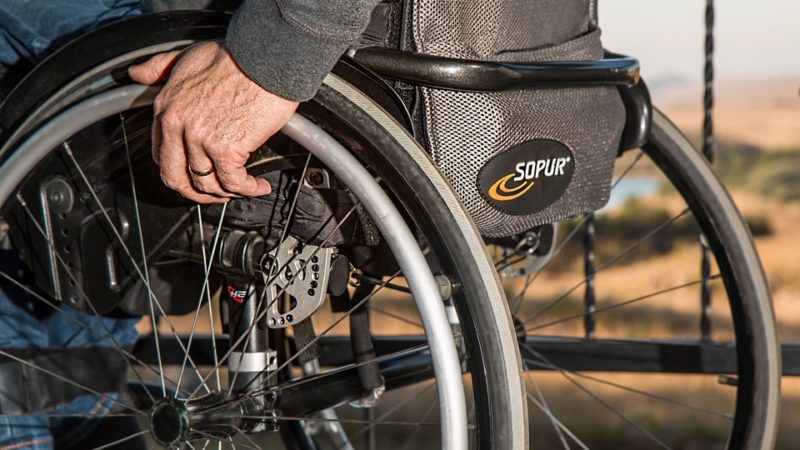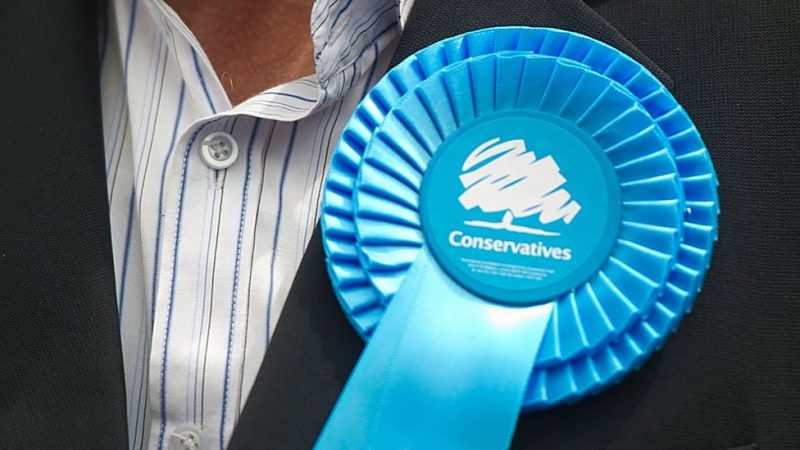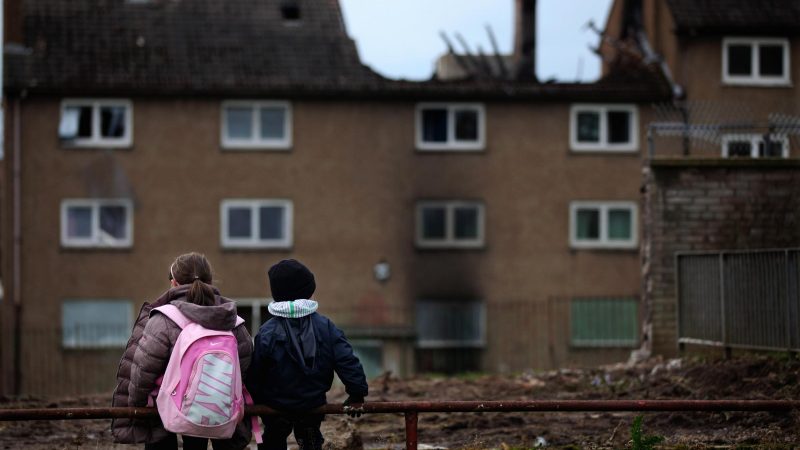Hannah Davenport

The government’s latest attacks on disability welfare has caused further outrage and concern from campaigners, charities and MPs as the Tories announce further cruel plans to cut disabled people’s benefits.
It comes as earlier this month Rishi Sunak announced a heartless clamp down on disability welfare with the aim to toughen the eligibility criteria for Personal Independence Payment (PIP), plans described as ‘an assault on disabled people’.
More proposed changes are being announced ahead of the publication of a “green paper” consultation, as the Work and Pensions Minister Mel Stride gave further details this morning on just how cruel the Tories planned welfare reforms are.
Speaking to the media today, Stride said that people with depression or anxiety could lose access to sickness benefits under the new reforms, while the Telegraph reported it could also see disabled people stripped of a monthly cash payment and provided vouchers instead.
Rishi Sunak said he wants to get more people into work and reduce the government’s welfare bill, with Stride referring to it as a “sustainability issue”. But plans to tighten the eligibility criteria for PIP have been blasted by critics with heavy criticism also aimed at the government’s harmful rhetoric towards disabled people.
The organisation Disability Rights UK said the government’s narrative that disabled people are a burden on the benefits system is “utterly untrue”, as the group reacted to the latest plans.
“Today, the Government have yet again gone on the attack by singling out Disabled people as a burden on the benefits system,” Disability Rights UK reacted. “Utterly untrue, but we continue to be the whipping community for ALL government economic failure. Enough. This is just cruelty.”
Executive Director at the disability equality charity Scope, James Taylor, said today that it was hard to have faith that the consultation was “about anything other than cutting the benefits bill, no matter the impact.”
“Life costs a lot more for disabled people, including people with mental health conditions. Threatening to take away the low amount of income PIP provides won’t solve the country’s problems,” Taylor said.
He hit back at the Prime Minister’s claims that ‘mental health culture’ had gone too far and blasted the government’s record on crumbling public services, poor quality jobs and increased rates of poverty.
“The government needs to end this reckless assault on disabled people and focus on how to fix the real underlying issues,” said Taylor.
Activist and journalist Rachel Charlton-Dailey said on X: “The whole point of benefits is to help disabled people live. Vouchers would limit where we spend our cash and “claiming back” would put us into even further debt. The tories want us dead.”
One disability campaigner wrote today on X: “Be nice today to do anything without bursting into tears at the sheer cruel, vindictive & sadistic unfairness of it all. What do I say to my disabled daughter about her future? What do I say? How do I tell her the future under this government is one they don’t want her in?”
Social change group Joseph Rowntree Foundation highlighted the link between disability and poverty, and warned against playing “political football” with people’s lives.
“Almost two thirds of people in destitution have a chronic health condition or disability. People in this position shouldn’t be used as a political football. We need action, not rhetoric from politicians”, the non-profit wrote.
“PIP is a benefit to help people with the additional costs of having a long-term physical or mental health condition or disability. This benefit is a big share of many claimants’ income.
“Cutting it will lead to a large hit to future claimants’ living standards.”
In households where an individual receives PIP and no-one is in work, seven in ten working-age adults are in material deprivation, this is three times the rate across all working-age households. In these households 40% experienced food insecurity and over 30% were unable to keep their homes warm.
Labour’s Shadow Minister for Disabled People Vicky Foxcroft accused the government of scapegoating disabled people and those with long-term health conditions for the problems they have created.
“PIP was created by the Tories but isn’t working for disabled people (or the taxpayer).DWPgovuk too often fails to get decisions right first time, leading to lengthy delays, reassessments and a stressful appeals process.”
Labour MP Marsha de Codova said it was “despicable” that the Tories are “yet again scapegoating disabled people”, “planning cruel cuts” in order to “distract attention from their mess”.
Doctors have also hit back at the government’s proposals to cut PIP and penalise those with mental health conditions.
Consultant Dr Jay Watts commented: “Dear Mel Stride,
“PIP has nothing to do with employment. PIP is for moderate to severe disability and is v difficult to qualify for. Noone gets PIP ‘for’ depression or anxiety. It is based on a functional analysis. Stop playing smoke and mirrors with people’s lives.”
A palliative care doctor wrote on X: “Mel Stride is no doctor, and nor is Rishi Sunak. They have no idea how crippling severe depression or anxiety can be. They’re simply smearing the vulnerable for cheap, populist, electoral gain. It’s vicious, unforgivable stuff.”
Whilst mental health charities also highlighted the huge waiting lists even to access mental health support and the need to focus on investing in the chronically underfunded sector.
Mental health charity Mind said: “People don’t choose to be on disability benefits. It’s their last resort.
“Stop blaming people with mental health problems. If the Secretary of State wants a grown-up conversation about this, then he should meet with us. We’ve sent an invite.”
A group of charities have backed a petition launched by Scope in reaction to the welfare cuts which demands that the government; stop demonising those who cannot work, support people who want to work and advocate for a benefits system that is kind.
(Image credit: UK Government)
Hannah Davenport is news reporter at Left Foot Forward
The government’s latest welfare changes are a full-scale assault on disabled people
'Disabled people are not the problem'
Left Foot Forward Opinion

TweetShareWhatsAppMail
James Taylor is director of strategy at the disability charity Scope
It’s no overstatement to say we were horrified by the government’s latest announcements to deal with economic inactivity in this country. It feels like a full-scale assault on disabled people.
And it’s the latest in a long line of rhetoric which claims to be “helping” disabled people, but will only make life much more difficult for the UK’s 16million disabled people.
Earlier this month, the Prime Minister Rishi Sunak outlined his “moral mission” of reforming welfare to give everyone who can, the best possible chance of returning to work.
On the face of it, supporting people who want to work but don’t currently have a job is laudable. We know there are many disabled people locked out of work because of negative employer attitudes, inflexible workplaces and failures with the Access to Work scheme. But that’s not what last week’s announcement will achieve. These proposals are unlikely to work, and what’s more, they don’t add up. All they will do is push people further away from a job, and deeper into destitution.
Since Friday’s announcement, a deeply troubling report from the United Nations Committee on the Rights of Persons with Disabilities (UNCRPD) has found the government’s welfare reforms are “premised on a notion that disabled people are undeserving and wilfully avoiding employment”, which has “resulted in hate speech and hostility towards disabled people”.
Scope has also launched a petition urging the government to stop demonising people who can’t work.
The current government seems to be hellbent on cutting the benefits bill, making it harder to access financial support, and waging a war against disabled people.
It is true for the government to say we currently have incredibly high levels of economic inactivity. And people who are long term sick or are disabled are more likely to be economically inactive than other groups.
But disabled people are not the problem.
The reason for this isn’t because ‘life on benefits is easy’ (in fact it’s not, many people who claim benefits live in deep poverty). It is because our public services are crumbling, the quality of jobs is poor and the rate of poverty amongst disabled households is growing.
Is it any wonder health is deteriorating when the overall number of waits for non-emergency treatment in England was 7.5 million in February. When it comes to mental health, according to the charity Mind, there are more than 2 million people waiting to access treatment.
Announcements from the Prime Minister to make the welfare system tougher and more punitive won’t address this health crisis. In fact, they are highly likely to be detrimental to health, pushing people further from work. There is plenty of evidence to show this approach is totally counter-productive and, ultimately, more costly.
What we need is a fundamental rethink about how we value disabled people in this country, and how we can genuinely support individuals – without the threat of being sanctioned and having their benefits cut off – through the welfare system. Making, or threatening to make, a system harder to access just won’t do. And it ends up demonising disabled people.
If this government – and whoever forms the next government – is serious about wanting to help disabled people “reach their potential”, they need to invest in creating opportunities for disabled people, and removing the barriers in society which make it impossible but are out of individuals’ control.
Scope has just launched our Manifesto for An Equal Future, which sets out what the next government needs to do to transform disabled people’s lives. Change is possible, but it won’t be achieved this way.
There needs to be a bigger focus on employers, on flexibility to try working without fear of repercussions, and investment in the public services that are designed to keep us well and which presently are struggling.
Successive recent governments have set their sights on the disability employment gap – the difference in the employment rate of disabled people and non-disabled people. Yet it’s stayed at around 30 percentage points (roughly 80% vs 50%) for more than a decade.
The government claims it wants to help more disabled people get into work, and yet it’s stripping away the actual schemes that might support people find a job, if it’s right for them. They are ending the Work and Health Programme, the one national employment support programme for disabled people. In its place will be smaller programmes – WorkWell and Universal Support. Both of which are delayed, both of which are far less ambitious in the amount of individuals they intend to support.
And the government needs to be cracking down on employers’ negative attitudes. Many workplaces continue to discriminate against disabled applicants or workers.
Scope’s employment services help disabled people find and apply for the jobs they want. We’ve heard from people who’ve had job offers taken away after they told their employer they were disabled.
One neurodivergent customer was made to leave their job after asking if they could move their desk to allow them to concentrate better.
Other customers weren’t allowed by their employers to use assistive technology to help with admin.
The government needs to make sure disabled people can get the right support in work. Access to Work is a central fund which helps cover the cost of equipment and other support someone might need to do their job.
But the system is nowhere near flexible enough, isn’t given the right level of investment, there are huge backlogs, and many employers have never heard of it. We’ve heard from people who’ve had to leave their jobs after a few months because Access to Work was too slow to come through.
These latest announcements also see the government wanting to cut Personal Independence Payment (PIP), which helps cover the extra costs disabled people face. These costs include things like needing to use taxis because public transport isn’t accessible. Needing specialist equipment such as electric wheelchairs and bed hoists. Or needing to use more energy for heating because your condition makes it much harder to regulate your body temperature.
Scope’s analysis found these extra costs add up to £975 a month, even after someone’s PIP is taken into account. These extra costs mean the cost-of-living crisis has been particularly devastating for disabled people.
Our helpline at Scope has been inundated with calls from people having to ration how much they can use their wheelchairs because they can’t afford to charge them. Using candles instead of switching the lights on. Going without food for days. For the government to want to cut support is truly horrific.
And this financial hardship predates the latest crisis. The number of disabled people living in poverty has grown enormously over recent years. There are 1.8million more disabled people in poverty now compared with 15 years ago.
Support for disabled people has been squeezed and squeezed over the past decade. For 4 years, many benefits were frozen so didn’t increase in line with inflation – a real-terms cut. Then in the midst of rampant energy hikes, the government quietly cut eligibility for the Warm Home Discount – around £150 a year – for 300,000 disabled people with the highest support needs. And there was a callous disregard for disabled people during the covid pandemic, whose needs were largely forgotten despite making up 6 in 10 of all those who died.
Disabled people make up a quarter of the population, but we have been failed by successive governments for far too long.
We are a force to be reckoned with, and it’s time our voices were heard.
We want the next government to tackle the extra costs of disability. To transform attitudes to disability. To ensure that those of us who want to work can do so. To fix the broken benefits system.
It’s more crucial than ever that the next government puts a stop to these dangerous and lazy narratives demonising disabled people, and instead starts to tackle the real issues with new ideas.
Only by doing that can they create an equal future for all of us.
You can sign Scope’s petition, demanding the government stop demonising disabled people on the following link.

An all-out attack against disabled people – DPAC
Linda Burnip, Disabled People Against Cuts
Last Friday, April 19th, Rishi Sunak launched an all-out attack against disabled people and their rights. It seems the timing of this may have been related to the government receiving the latest damning report from the UN Disability Committee.
The report highlights the government’s shameful failure to make any significant progress with human rights for disabled people since 2016. Further, there has been actual regression in the government’s policies and their implementation and the continuation of the government’s “grave and systematic violations” of disabled people’s human rights.
The report outlines many of the major discriminations which disabled people continue to experience, including the appalling poverty in which many live; the increasingly dire welfare benefit system; the ongoing issues around employment; the unacceptable levels of neglect, coercion, abuse and deaths in psychiatric hospitals; the continuing need to put an end to all forms of institutionalisation which has been increasing and to ensure that disabled people can live independently in the community and achieve their whole potential.
This report was produced before the horrific changes Sunak announced to the social security system.
Sunak attempted to justify the proposed changes by saying the system lets people down by not being focused enough on work and what disabled people might be able to do, while totally ignoring the multitude of barriers faced in getting and keeping employment. Not least of these is the six month backlog in assessments for Access to Work funding – and if you’ve ever looked into the lack of jobs based solely on working from home, you’ll know they are non-existent.
Some of the disastrous changes proposed by Sunak include a change to the Fit Note process, stopping all payments if someone does not comply with conditions set by a Work Coach, and a pledge to “tighten” the Work Capability Assessment.
He also announced that Personal Independence Payments (PIP) will be given a major overhaul, with a new consultation set to launch in the near future, specifically looking at changes to the eligibility criteria, assessment process and types of support that can be offered particularly, but not solely, affecting people with a Mental Health condition.
The Prime Minister said that “people with less severe mental health conditions should be expected to engage with the world of work” as he set out the UK Government’s new plans. He quoted a figure of 1.35 million people having anxiety and depression but failed to say that of these 1 million people had anxiety and depression as a secondary condition which I’m sure in many cases is due to the ever-growing waiting lists for NHS treatment.
The PIP reform would only apply in England and Wales as people in Scotland currently on PIP will move to Adult Disability Payment (ADP) and the devolved Social Security Scotland IT system before the end of 2025.
So what exactly are Sunak’s plans?
Removing benefits from the long-term unemployed who do not accept a job
New legislation will be put forward in the next Parliament to change the rules so that anyone who has been on benefits for 12 months and doesn’t comply with conditions set by their Work Coach – including accepting available work – will have their unemployment claim closed and their benefits removed entirely.
Amending Work Capability Assessments
Sunak explained that the UK Government is committed to removing the Work Capability Assessment (WCA) entirely and introducing a new personalised, tailored approach to employment support, with the aim of helping disabled people and people with health conditions into work. However, these assessments would be carried out by Department for Work and Pensions staff with no medical training or qualifications, which potentially is an even more frightening prospect than having an Occupational Therapist or Physiotherapist assessing someone’s mental health condition, as is the situation currently.
The planned reforms are expected to reduce the number of people assessed as not needing to prepare for work by 424,000 by 2028-29.
Review of the Fit Note process
The Prime Minister has also announced a review of the Fit Note system to stop people being signed off as “not fit for work”. As part of this, the UK Government will consider shifting the responsibility for issuing the Fit Notes away from GPs, while creating a system where yet more medically unqualified staff will decide if you’re ill or not. This of course may simply be a good way to hide the falling numbers of GPs that there are now following Brexit. The other major flaw with this plan is: how would people in work get signed off if ill for more than five days?
Employment experts, however, say that the number of fit notes issued last year hasn’t risen since before the pandemic.
Accelerating legacy benefits move to Universal Credit
The rollout of Universal Credit will be accelerated to move all those left on Employment and Support Allowance (ESA) onto the modern IT system, although there seems to be much confusion within the DWP itself about when this could actually happen.
Changes to Administrative Earnings threshold
The UK Government has already set out regulations to increase the Administrative Earnings Threshold (AET) in Universal Credit based on how much people currently earn and how many hours they work. Anyone earning below the AET, will be placed in the Intensive Work Search Group and are required to regularly meet with their Work Coach. This of course is likely to be very negative for disabled people as many work part-time on a self-employed basis.
The threshold will rise from £743 to £892 for individual claimants and £1,189 to £1,437 for couples – or the equivalent of 18 hours at National Living Wage a week for an individual from May.
Cracking down on fraud
The Data Protection and Digital Information Bill will already enable the DWP to access people’s bank account details but Sunak says a new fraud bill will be introduced in the next Parliament which will give sweeping new powers to the DWP to carry out warrants for searches, enforce seizure of property from homes and carry out arrests. These are powers normally reserved for the police.
Figures for overpayments of PIP show that in the year ending 2023 overpayments of PIP due to fraud was a mere 0.2% which, when compared to the levels of tax evasion seemingly practised by many Tories, is an utterly insignificant amount of money.
- Linda Burnip is co-founder of Disabled People Against Cuts (DPAC). You can follow DPAC on Facebook, Twitter/X and Instagram.
- This article was originally published by Labour Hub on April 26th, 2024.















